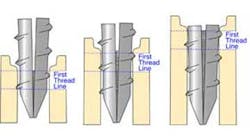This article first appeared in the newsletter, DE's Breakthrough Clinical with Stacey Simmons, DDS. Subscribe here.
Dental implants and implant-retained overdentures have truly advanced dental care for patients. Implant-retained dentures provide your patients with the confidence of no longer being afraid or embarrassed of a denture that might slip when they eat, talk, or laugh, along with the important benefit of less bone loss. While implants may be an option, they are an expensive one. The clinician must always be cognizant that some patients simply cannot afford implants or may be unwilling to undergo surgery.
Fortunately, in these cases, there is an alternative. If patients have a couple of remaining bilateral teeth, they could be used to support partial dentures or overdentures at far lower cost. To maximize the longevity of these teeth as denture supports, it is advantageous to cut them down to the height of the gingival and place a post with a ball attachment that locks into a female attachment luted into the denture. By cutting down to the gingival, we keep the tooth, acting as a lever arm, as short as possible. The shorter the lever arm, the less magnified the functional stresses, which is a plus for the supporting root. An intact tooth having a clasp around it is subjected to functional stresses, causing small movements of the clasp that can lead to erosive wear of the tooth. A precision or semi-precision attachment increases the functional stresses to the tooth, because the rigid retainer fit does not allow for the small amounts of movement that dissipate the stresses when a clasp is placed.
ALSO BY DR. BARRY MUSIKANT |Endodontic insight: Maximizing canal cleansing with minimal dentinal weakening
By cutting the tooth down, amplification of the forces of occlusion through the lever arm are minimized. The placement of a ball attachment placed at the level of the root keeps the height of the lever arm low. The ball itself allows some degree of rotation under function, further reducing the stresses that go to the root. Key to the placement of any overdenture is the continuing inspection of the supporting ridge. As bone shrinks along the ridge, the stress to the supporting teeth will increase unless the dentures are relined. The consequences of not relining when necessary is an increasing transference of stresses to the overdenture post and the supporting root that can lead to fracture of the root or the post. By simply relining the denture, this problem is averted.
While we like the concept of a ball-and-socket attachment for the retention of an overdenture, there are a few other issues we should address. First, would it be advantageous to create a coping over the overdenture root? There are two schools of thought here. A coping is placed to be protective of the root, but a patient with only two teeth left may not be one where a coping is truly protective. How many teeth did the patient have in the past that were crowned, thus protected and ultimately removed? Perhaps, the daily application of a fluoride gel directly onto the root surface will accomplish more in maintaining the integrity of the remaining supportive roots than the placement of copings. Furthermore, if the patient’s finances are compromised, the elimination of a coping as an added expense is eliminated.
ALSO BY DR. BARRY MUSIKANT | Endodontic insight: Thorough root canal cleaning and shaping while preserving tooth structure
The second issue is the design of the shaft upon which the ball sits. Here, the split shank of the Flexi-Overdenture represents an effective design (figure 1). As is always the case when placing posts, we want a combination of high retention, minimal insertional stresses and as even a distribution of functional stresses as possible. The only way to attain this desirable combination is to incorporate threads along the length of a shaft that has a split originating at the tip of the post and extending at least two-thirds up its threaded portion. Given this design, the initial thread that would normally embed itself into the dentin to a depth of 0.1 mm and produce significant insertional stress only embeds itself into the dentin to a depth of 0.01, producing minimal insertional stresses. In like manner, the subsequent thread embeds itself 0.03 mm into the dentin, an incremental increase of 0.02 mm. The third thread embeds itself to a depth of 0.05 mm, only requiring a 0.02 mm incremental increase in depth (figure 2).
As you can see, the amount of stress produced when a split-shank threaded post is inserted into the root is far less than would be generated by an identically designed post without a split. Of equal importance is the realization that whatever forces are generated are not concentrated in the lead thread the way they would be on a solid-shank post. Rather, they are distributed quite evenly over the entire length of the post within the root.
A design that minimizes the stresses within the root as the threads engage the dentin now takes advantage of the stress-distributing properties that a thread gives a post. Where a passive parallel post will concentrate functional stresses apically, the thread provides for an equal distribution of stress along the entire length of the root. The even distribution of functional stresses can only be attained by the use of a thread, but a thread can only be placed if it can embed itself into the dentin in a nonstressful manner, and this can only be accomplished by the incorporation of a split along the working length of the post. While the split shank is the most unique feature of the Flexi-Overdenture, the incorporation of a second tier and an even wider coronal flange produce a more intimate metal-to-dentin interface that increases stability in the post’s placement.
The split shank, second tier, and flange together produce a degree of stability that no other post offers (figure 3). Retention of the denture to the post is accomplished via nylon socket that is itself cold cured into the denture. Most of the time these nylon sockets are effective for two or more years, but on rare occasion they will only last a few months for reasons that have not been completely determined. The replacement of these nylon sockets take about 30 minutes of chair time to replace and require an office visit. This problem has been reduced to a minor inconvenience with the placement of the EZ-Change attachment (figure 4), a metal cap, incorporated permanently into the denture that is itself a receptacle for the nylon socket (figure 5). Whether the nylon attachments last a couple of years or only several months, they may now be replaced within seconds (figure 6). The replacement is so simple that patients can do it if they are given extra nylon sockets and a little two-pronged wrench.
The Flexi-Overdenture succeeds because of the innovations on both ends: retention into the root and retention to the denture. The root retention is stable and long term because of the safety built into the overdenture’s shaft design. The retention to the denture is mostly long lasting and easily replaced on the rare occasions it fails. In short, this is a perfect example of optimizing clinical results through innovative design concepts.
This article first appeared in the newsletter, DE's Breakthrough Clinical with Stacey Simmons, DDS. Subscribe here.












